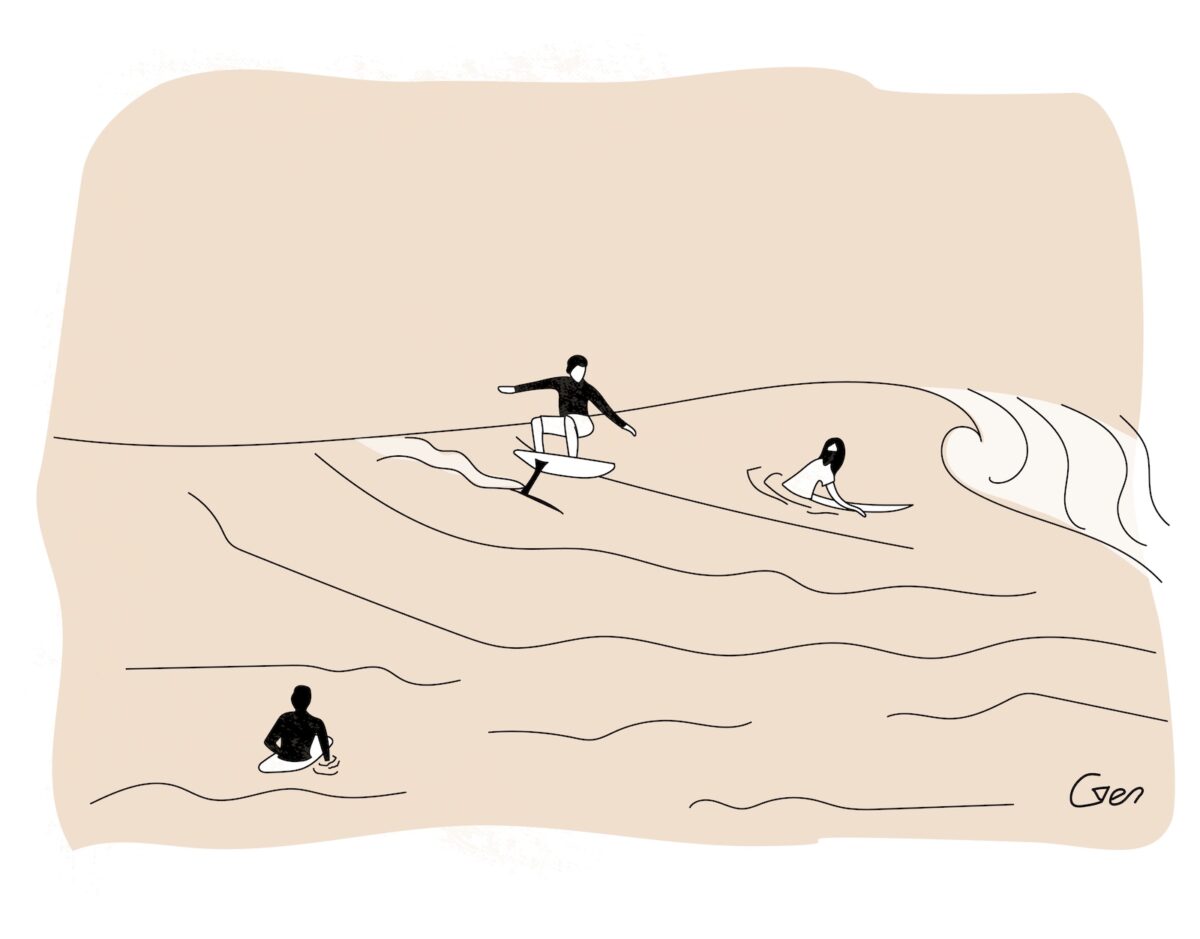Foil surfing is a sport gaining popularity worldwide. Head down to many surf breaks, and you’ll likely see more than a few energizer-bunny types pumping their way through the lineup, catching waves before they are waves, and generally being a menace to the rest of us wave riders.
Shortboard surfers used to feel resentment towards longboarders, who sometimes paddle further out and hog the lineup. But now we have a common enemy — the most annoying of water users, the foiler.

A brief history of hydrofoil surfing
The idea of hydrofoils can be traced back to the early 1900s when they were first used on boats to reduce drag and increase speed. But it wasn’t until the 1990s that a few pioneers, including Laird Hamilton, started experimenting with hydrofoils on surfboards. Laird is a legendary waterman; for many non-surfers, he is the golden boy / man of surfing. He was looking for ways to catch bigger waves and ride them more smoothly, so he attached a hydrofoil to his surfboard, ensured a video crew was on-hand, and a subculture was born.
In the early 2000s, a few other pioneers like Dave Kalama and Rush Randle joined the party, helping to refine and develop foil surfboard shapes and designs. More recently, Kai Lenny took the reins, releasing some incredible foiling footage in 2016 that ignited a new surfing era.
How does foiling work?
You might wonder how you catch a wave on one of these things. Well, it’s actually a bit different from traditional surfing. With foil surfing, you usually start by paddling or using a tow-in method with a jet ski, and then you have to drive yourself toward the right spot on the wave to get enough speed. Once you’ve got the speed, the hydrofoil does its magic and lifts you up, allowing you to ride above the surface. Remember — the wave doesn’t need to be breaking. A swell or ripple will do.
These days, foil surfing has evolved even further, with people using eFoils, which are electric-powered hydrofoil surfboards. Sounds like a bad dream? You’ve got it. To make matters worse, you can also find standup paddle board foils 🤢 and wind foils.
The risks of foil surfing
In action, the hydrofoil lifts the surfer above the water’s surface, reducing drag and enabling the rider to reach higher speeds even through fat and almost flat sections. While this newfound agility might be exhilarating, it presents a set of hazards that can impact the safety of those paddling out or waiting further inside the lineup.
Note that this section of the article refers to the plague of new foilers. If Kai Lenny unpacked his beast in my local beach car park, I’d be keen to watch him in action. Great foilers, like masters of most sports, know how to keep themselves and others safe, while performing radical maneuvers. It seems that great foilers go and surf in intentionally uncrowded places because they get to have more fun.
However, what we’re seeing in reality, is novice foilers paddling out at busy breaks, weaving between surfers and other ocean users in an epileptic dance that will undoubtedly end in tears. Foils have already caused some serious accidents such as this and this, with many surfing advocates calling for a ban.
Why is hydrofoil surfing dangerous?
- Increased Speed and Unpredictability: Foil surfing allows riders to reach higher speeds than traditional surfers, making it difficult for swimmers and surfers to anticipate and react to their movements. This unpredictability can lead to collisions, posing a significant risk to those in the water.
- Sharp Components: The hydrofoil’s metallic wings and mast are sharp, and a collision with these components can cause serious injuries. In the event of a high-speed impact, these sharp edges can cause cuts, bruises, or even more severe injuries, especially to inexperienced swimmers and surfers.
- Difficulty in Control: Foil surfing has a steeper learning curve than traditional surfing. Controlling the hydrofoil requires skill and experience, which not all riders possess. As a result, novice foil surfers may struggle to maintain control, increasing the likelihood of accidents and endangering nearby ocean users.
- Limited Visibility: Foil surfers often ride in areas where waves are smaller or less crowded. While this may sound like a safe practice, it can make them difficult to spot by traditional surfers and swimmers. As the hydrofoil lifts the rider above the water’s surface, they may be obscured by waves, making it challenging for others to see them and avoid potential collisions.
- Restricted Surf Zones: While some beaches have designated zones for different water activities, not all areas have such regulations in place. In the absence of designated foil surfing areas, these surfers may share the same space as swimmers and traditional surfers, increasing the risk of accidents.
Why do foil surfers insist on surfing in busy spots?
There are a few reasons why foilers might choose to surf at a busy surf break. One is because they are easy to access. Busy surf spots usually boast easy access, and the crowd most often sits in a pack where the wave breaks. Often, you will find empty waves breaking a few hundred meters down the beach. Another reason is that foilers actually want to show off their wave-foiling prowess. After all, they can catch more waves than conventional surfers, so why not demonstrate this ability?
A final reason is a complete lack of self-awareness. They don’t even realize they’re a menace. They think they’re cutting-edge and cool.
Creating a Safer Environment
Although foil surfing poses certain dangers to fellow ocean users, minimizing these risks and promoting safety for all is possible. Here are a few recommendations:
- Establish designated zones: Beaches can create separate areas for foil surfing, traditional surfing, and swimming to minimize the risk of collisions.
- Raise awareness: Educate surfers and swimmers about the potential hazards of foil surfing and share safety guidelines to create a more informed and cautious community.
- Encourage skill development: Foil surfers should be encouraged to take lessons and practice in controlled environments before venturing into crowded waters.
- Utilize safety gear: Foil surfers should consider using safety gear, such as helmets and padded clothing, to reduce the risk of injury in the event of an accident.
Conclusion
Foil surfing offers a unique and fun experience for those who seek to ride waves in a new and exhilarating way. However, it is crucial to recognize the dangers this sport presents to other ocean users.
By implementing safety measures, increasing awareness, and fostering a culture of responsibility, we can ensure that foil surfing continues to grow in popularity without compromising the safety and enjoyment of our beloved ocean playground.
Foil surfers – many of you were once, or are still, regular surfers. You know the drill. Do your weird bouncy dance a bit further down the beach and we might even celebrate the fun you’re having. Weave your way through busy lineups and you’ll probably ruin the fun for all of your kind. One maiming of a surfer or other water user and your crafts will be categorized as vehicles — like Jetskis — and your time in our lineups will be done.






